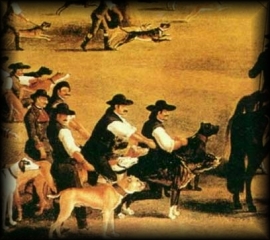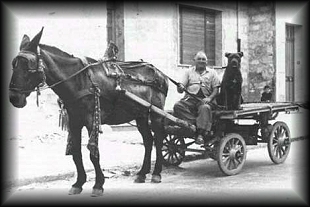Ancient History
 The origins of this breed could be traced back to the Mesopotamical Molossians, as could most Mastiff type dogs of Europe. These ancient Molossors are depicted in a number of sculptures and paintings from the period. These relics depict a large ferocious dog with heavy bone a short blunt muzzle and cropped ears. There are differing theories on how these predecessors to the Cane Corso eventually arrived in Italy; one hypothesis is that they traveled through China, India, finally reaching Europe with the migrations of the Assyrians of Alexander the Great, Phoenicians and Romans. Another school of thought is that ancient tribes (called Molossians) arrived in Greece during the Greek-Persian wars, with Xerxes and the Cirrus Army. The Greeks and Macedonians brought with them large dogs that they utilized for warfare and the hunt. Marco Polo described these dogs as "large as donkeys"
The origins of this breed could be traced back to the Mesopotamical Molossians, as could most Mastiff type dogs of Europe. These ancient Molossors are depicted in a number of sculptures and paintings from the period. These relics depict a large ferocious dog with heavy bone a short blunt muzzle and cropped ears. There are differing theories on how these predecessors to the Cane Corso eventually arrived in Italy; one hypothesis is that they traveled through China, India, finally reaching Europe with the migrations of the Assyrians of Alexander the Great, Phoenicians and Romans. Another school of thought is that ancient tribes (called Molossians) arrived in Greece during the Greek-Persian wars, with Xerxes and the Cirrus Army. The Greeks and Macedonians brought with them large dogs that they utilized for warfare and the hunt. Marco Polo described these dogs as "large as donkeys"
The Greeks colonized Italy and brought these ferocious Molossans with them. When the Roman Empire conquered Italy they discovered the Molossiod dog's virtue as a fighting dog. The Romans developed from these Molossiod dogs what came to be known as Canis Pugnax (the Roman war dog). It is believed that from this Ancient Molosser the modern day Cane Corso and Neapolitan Mastiff have been developed. The name doesn't derive from the geographical origin of the breed, some believe that the name comes from the Latin "cohors", which means "guard" or "protector" (examples are: "praetoria cohors"= Praetorian guards and, more recently in the Vatican City, "Cohors Elvetica"=swiss guards) with regard to this theory, its very interesting the hypothesis which identifies the roots of the Corso in the Greek word Kortos, which means "enclosed court", and from which derives the above mentioned cohors.
 Consequently, Cane Corso would mean "the dog that watches the court". This hypothesis, if true, would take us back to the "Magna Grecia" (the ancient Greek colonies of southern Italy) and to the attractive oriental origins of the Molossian. Others believe that Corso is derived from an ancient Celtic-Provincial acceptation under which "strong and powerful" was understood. This latter theory is equally plausible, as it is nowadays in some words like the English "coarse" (as opposed to "fine") and in some southern Italian dialects where "Corso" means coarse, strong or bold. What is certain is that from the origination of the Italian language, the Molossian was always called "Corso".
Consequently, Cane Corso would mean "the dog that watches the court". This hypothesis, if true, would take us back to the "Magna Grecia" (the ancient Greek colonies of southern Italy) and to the attractive oriental origins of the Molossian. Others believe that Corso is derived from an ancient Celtic-Provincial acceptation under which "strong and powerful" was understood. This latter theory is equally plausible, as it is nowadays in some words like the English "coarse" (as opposed to "fine") and in some southern Italian dialects where "Corso" means coarse, strong or bold. What is certain is that from the origination of the Italian language, the Molossian was always called "Corso".
There are numerous references to the Cane Corso throughout history in terms of art and literature i.e. Teofilo Folengo in the "Maccheronee" (1522), Konrad von Gesner in the "De Quadrupedibus" (1551), Erasmo di Valvasone in his poem "Hunting" (1591), Mina Palumbo in the "Mammiferi di Sicilia" (1868), Giovanni Verga in the "Malavoglia" (1881), Erasmo di Valvasone's (1523-1593) poem "La Caccia" (the hunt) from 1591, Giovanni Battista Marino (1569-1625) mentions Cane Corso, in his book "La Sampogna" paintings and sculptures of Corso like Molosser's appear in the Royal palace of Caserta and the prints of Bartolomeo Pinelli's (Roma 1781-1835) Pirelli's depictions in particular stand out as they are grafic in their detail, they show the Pugnaces devouring Christians in the coliseum, locked in combat with each other, and bull-baiting. After the fall of the Roman Empire the Cane Corso proved its versatility by being employed in numerous varying tasks mostly in Southern Italy in provinces like Foggia, Puglia, Bari and Campobasso. The primary task's where that of guardian, hunter and farm dog. The Cane Corso's versatility made it an idea farmhand. He was well suited as a flock guardian, often deployed in the war with the wolves. In these times the Cane Corso often wore collars made of steel with spikes so when they fought with the wolves they would have an advantage.
 The Cane Corso often would take off after the wolves and abandon the flock, many of these wolves employed tactics similar the Native American Indians where they would send a decoy to entice the Cane Corso(s) to give chase, thus leaving the flock virtually unguarded. This posed a problem for the Shepard's. Their solution was too crossbreed the Cane Corso with a native Italian herding dog, the Maremmano-Abruzzese. The Maremmano had a strong attachment to the sheep and was less likely to take off after the wolves. This produced a dog that was capable of fighting of a wolf, but stayed close to the flock, this crossing was called a "Mezzo-Corso."
The Cane Corso often would take off after the wolves and abandon the flock, many of these wolves employed tactics similar the Native American Indians where they would send a decoy to entice the Cane Corso(s) to give chase, thus leaving the flock virtually unguarded. This posed a problem for the Shepard's. Their solution was too crossbreed the Cane Corso with a native Italian herding dog, the Maremmano-Abruzzese. The Maremmano had a strong attachment to the sheep and was less likely to take off after the wolves. This produced a dog that was capable of fighting of a wolf, but stayed close to the flock, this crossing was called a "Mezzo-Corso."
The Cane Corso was also used as a "cattle dog" or "butchers dog". The beef was raised in wild pastures until the time came for the cattle to be brought to slaughter by the "butteri" (the Italian counterparts to our cowboys). More often than not the herds would have to be driven great distances to be slaughtered. These were essentially "wild" animals and had to be treated with great caution. In order to keep the herd manageable the bulls had to separate, the Cane Corso accomplished this by using its vise like grip on the bull's nose; the pain was so great that it completely incapacitated the bull. This practice became a popular attraction called "bull baiting" The Cane Corso during these journeys had to keep a vigilant watch for predators, as well as cattle thief's. Umberto Leone in his testimonial at the Conference of Civitella Alfedena in 1990 published in the Book IL Cane Corso by L'Orsa describes the dog's utilization with cows "The Cane Corso is particularly suitable to the needs of cow breeders. It accompanies the animals to the pastures and, on command; it brings back the ones that venture too far. It is very intelligent and it befriends the cows and calves.
 Recent History
Recent History
In 1995 Renzo Carosio is appointed standing auditor for the SACC. Mr. Carosio taking this responsibility with great commitment, reports his findings of irregularities and violations of the rules statute committed by the SACC to the ENCI and to the court. Additionally various complaints have been made to ENCI and the ministry of Agriculture regarding the running of the SACC.
The Association of Italian Cane Corso or AICC is formed on January 10th 1998. The AICC holds it's first show in June of 1998 and 103 Cane Corso's compete, a record number to date. August of 98' the AICC believing it has all the criteria met applies to ENCI for recognition as the official breed club of the Cane Corso. ENCI cash's the AICC'S application check, but is told that they must wait until the SACC situation is resolved. The AICC sets its sites on reaching out to the Cane Corso community abroad and recognizes the Cane Corso Club of the Netherlands, chaired by Mr. Eric De Vries. Then Vice President Carosio is invited to judge the CCCN National show. On February 4th 1999 during Minister's question time, the Vice President of the Italian Senate, Carlo Rognoni, asked the ENCI to intervene to absolve the SACC of all rights to represent the Cane Corso. March of 1999 the dissolution of the corporate bodies took place and an extraordinary commissioner was appointed to oversee the SACC.
July of the same year the SACC is removed from acknowledgement by ENCI as the guardian of the Cane Corso breed. April of 1999 the AICC reach's out the to the Cane Corso Association of America in an effort to open a dialogue for the future of the breed. This overture is met with great enthusiasm by the Americans and over time a bond between the organizations was formed.
Breed history information courtesy of our good friend and mentor - Mike Ertaskiran of Godiva Cane Corso
|